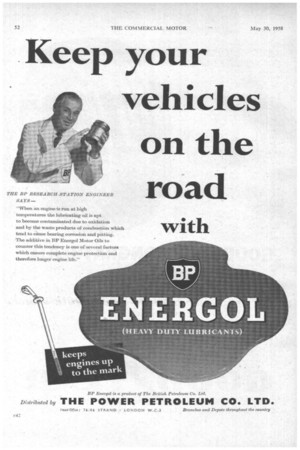Keep your vehicles on the road
Page 80

Page 81

If you've noticed an error in this article please click here to report it so we can fix it.
with
Pull handles assist in closing the driving-compartment doors, which are trimmed with leather cloth, and the door on the passenger's side can be locked from the inside. No interior light is supplied, and there is only one windscreen wiper.
Servicing this new Reliant is an entirely different proposition from the earlier model, particularly so far, as the engine is concerned. Access to the power unit is given by a trap in the " bonnet " moulding with a push fastener, and a large removable panel on each side of the engine cowl inside the cab, secured by single Dzus fasteners with coin slots.
Engine Oil Check The " bonnet " trap takes only 11 seconds to open, and with it up I was able to check the water level in the radiator in 61 seconds. Working through the trap I checked the engine oil level in 28 seconds, but found it easier to reach the dipstick by removing the right-hand interior panel. This added little to the total time and made it easy to reach the filler tube. This alternative method of checking the level took 35 seconds.
Three other jobs were done with the upper trap open. The first of these was to change a fuse, the fuse box being well placed for ready access on the right-hand scuttle section. A change took 15 seconds.
Next I checked the levels in the battery cells, this taking only 20 seconds. The battery is stowed just below the left of the trap opening, where it can easily be, reached.
Finally I checked the contact
breaker gap in 35 seconds, turning the engine over by rotating the fan as there was no starting handle. Closing the trap took less than a second.
Access to the brake-fluid reservoir, which is integral with the master cylinder, is given by removing a steel plate, secured by two small woodscrews, in the cab floor on the driver's side. The fluid level took 11 minutes to check, and the job was made a little fiddling because of the smallness of the screw heads. Bigger screws should be used.
I spent just over 6 minutes removing the four sparking plugs, and 34 minutes replacing them. Nos. 3 and 4 plugs are easily reached by removing the left-hand inner-bonnet panel, but the other two plugs can be reached— with difficulty—only through the top trap. The closeness of the dynamo, distributor and top hose to the plugs makes it difficult to get a spanner on to them.
It took 5 seconds to remove the left-hand . panel and 15 seconds to replace it, these times being included in those quoted for the sparking-plug job. With the panel off I removed and replaced the petrol-lift-pump filter gauze in 50 seconds. While doing this job I noticed that the valve-chest cover is much easier to reach than it was with the former Reliant van, so that adjusting the tappet clearances should not prove difficult.
To gain access to the gearbox filler and level plug there is a small removable panel in the left of the transmission tunnel; close to the passenger seat when one is fitted. This plate is held in place by two small screws,
which unfortunately do not have captive nuts, and the hole revealed does not provide sufficient space around the filler plug to wield a spanner of normal shape. Consequently I was unable to check this level.
Similarly, the pressed-steel openended spanner provided in the tool kit, which fits the rear-axle level plug, is not Strong enough to turn the plug when, as in my_ case, it is tight in its thread. Access to this plug can be obtained by. crawling under the rear of the van. _ Front Brake Adjusted A simple but efficient screw jack is provided in the tool kit, and using this I was able to jack up the front wheel, adjust its brake and lower the wheel in 21minutes. There are two hexagonheaded adjusters on the brake backplate, both of them being reasonably easy to reach.
Unfortunately there is still no spanner in the kit which will fit the small square headed rear brake adjusters, so I was unable to reset them.
However, three years ago I adjusted all three brakes in 11 minutes and on that occasion I found the front-brake adjusters difficult to reach, so presumably it should be possible to adjust all the brakes on the current van in under 8 minutes.
The new Reliant 5-cwt. van has a basic price of £320, and in Great Britain the additional purchase tax is £49 18s. 6d. This represents a total price increase of only £16 6s. 8d. over the previous model introduced four years ago.




























































































































